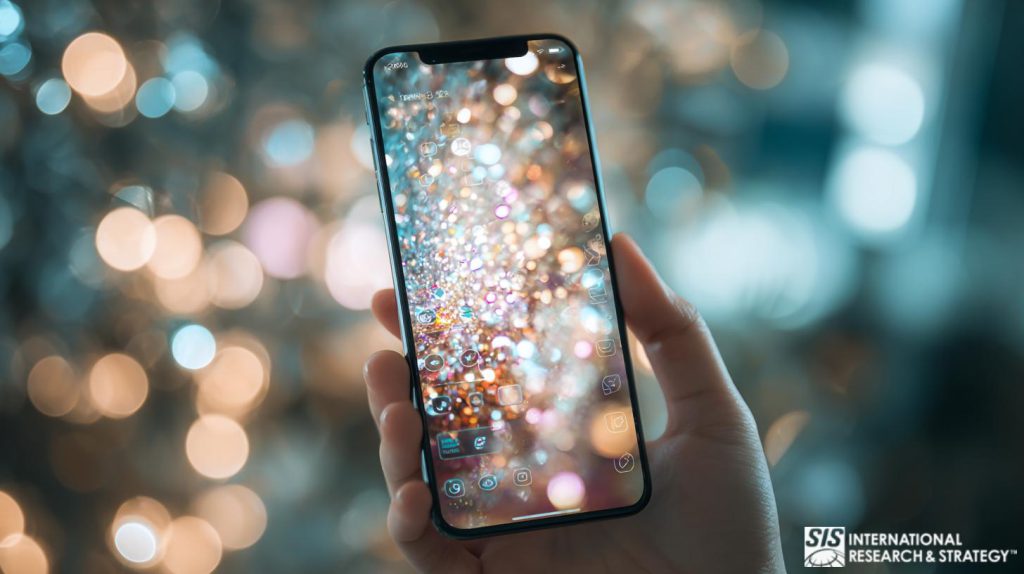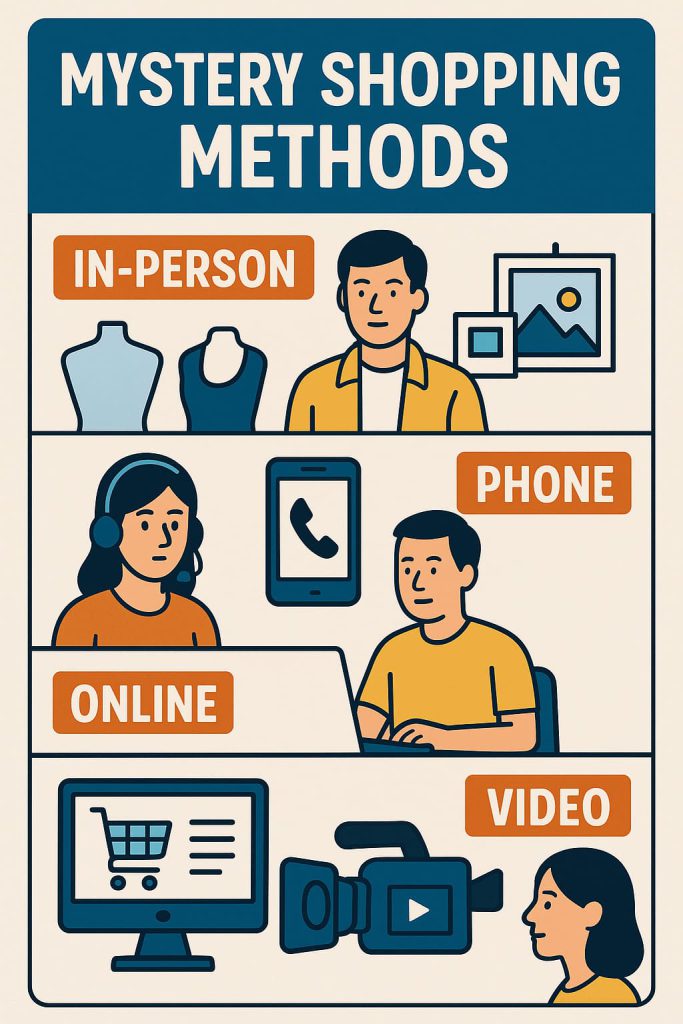Mystery Shopping Methods

The customer experience battlefield is where businesses live or die. And yet, most of companies have no clue what’s actually happening on their front lines. Mystery shopping methods are your secret weapon in a world where one bad experience can go viral faster than you can say “damage control.”
Table of Contents
✅ Listen to this PODCAST EPISODE here:
Why Most Mystery Shopping Methods Fail (And How the Smart Players Win)
The majority of mystery shopping programs fail because companies approach them as a mere check-the-box exercise. You shouldn’t have to put up with that.
Mystery shopping methods involve undercover evaluators posing as regular customers to assess your business operations… But here’s the truth nobody tells you: the method matters less than what you do with the insights.
So, harnessing the appropriate techniques in mystery shopping can completely change your brand’s perception. However, this can only be true if you are willing to confront the undeniable reality they expose.
In-Person Mystery Shopping Methods That Actually Move the Needle

The Walk-In Evaluation: Still King for a Reason
The walk-in isn’t sexy or innovative among mystery shopping methods. But it works like nothing else when executed with precision.
In our technology-driven society, you may think traditional walk-in evaluations are left in the dust. You would be gravely mistaken.
Your brand will always elicit the most deep-rooted emotional connection through face-to-face interactions. Businesses that operate with a physical store, the walk-in remains the most powerful of all mystery shopping methods.
Think about this: Luxury retailer ZenSpace (specific client details have been tweaked to respect confidentiality) implemented walk-in mystery shopping methods across their 21 locations last quarter. The shocking discovery? Their flagship store — supposedly their showcase location — had the worst greeting protocols in the entire chain. Customers waited an average of 6.7 minutes before any staff acknowledgment. After addressing this one issue, their conversion rate jumped 23% in just six weeks.
There is no customer satisfaction survey that will uncover operational truths like these traditional mystery shopping methods can. And people don’t know what they don’t want until they see what they don’t want.
To improve the effectiveness of these in-person methods of mystery shopping, consider the following tips:
- Create scenarios that test specific pressure points in your customer journey
- Use evaluators from different demographic groups (your 25-year-old shopper notices different things than your 65-year-old shopper)
- Schedule evaluations during peak times when your team is actually stressed
- Vary the complexity of customer needs (easy transactions vs. complex problem-solving)
Shop-Along Research: The Mind-Reading Technique Nobody’s Using
Are surveys the only way to get feedback on customers’ thoughts and feelings about their shopping experience?
Among the many techniques used in mystery shopping, shop-along research is the most psychologically insightful. It involves pairing customers with researchers who record thoughts and actions in real-time.
What’s fascinating is that people could cite dozens of reasons why they made decisions that are totally contrary to logic, and far out of reach of the actual conditions at play. The gap between reality and customers’ perception is where the greatest possibilities lie.
The beauty of shop-along mystery shopping methods is they capture the subconscious decision-making most traditional approaches miss entirely. While basic mystery shopping methods tell you what happened, shop-alongs tell you why it happened.
… But be warned: the insights can be uncomfortable. Are you ready to discover that your prized end-cap display actually confuses more customers than it attracts? Or that your sales team’s carefully crafted pitch points actually turn customers off?
Digital Mystery Shopping Methods for a Screen-Obsessed World

Website and App Evaluation:
Your website isn’t just a digital brochure. For most of your customers, it IS your business. Yet most companies implement sophisticated mystery shopping methods for their physical locations while neglecting the digital experience that drives 70% of their revenue.
That’s absolute madness.
Considered as the most up to date methods of digital evaluation, digital mystery shopping checks all areas of online presence through the lens of real users actively interacting with systems. There tends to be a gap – often quite wide – between how businesses perceive the functionality of their website and how customers actually navigate through it.
The most effective digital mystery shopping methods assess:
- First impression and appeal (you only have 2.7 seconds to impress) Navigation and user flow (is it smooth sailing or a stormy sea?)
- Search function usability (in this day and age, no one browses so serve it up)
- Responsivity of mobile devices (everything breaks if its poorly adapted for mobile)
- Frictionless points in checkout process (excess steps are a costing affair)
Unlike traditional mystery shopping methods, digital evaluations can be conducted at scale, with hundreds of testers across different demographics simultaneously. This creates statistical validity that in-person methods can’t match.
But here’s the catch: many companies implement digital mystery shopping methods but only look at technical metrics. They miss the Here’s the trick. While many firms utilize digital mystery shopping techniques, they often only pay attention to the quantitative metrics. They seem to ignore the emotional journey completely. Both matters if you want to monopolize the market.
Social Media Response Assessment: The Reputation Killer Nobody’s Watching
In an age where your brand is quite literally what people say about you online, these mystery shopping methods are survival tools.
Your clients expect replies to social media inquiries to be dealt with within half an hour. How is that working out for you?
Social media mystery shopping techniques go beyond checking if you provide feedback; they check how you deal with different situations on different platforms. In our nowadays hyper-sensitive cancel culture, a slip of the tongue in one response can spiral into a PR catastrophe in an instant.
The most revealing social media mystery shopping methods include:
- Testing crisis scenarios (How does your team react to potentially viral complaints?)
- Cross-platform consistency evaluation (Does the brand voice retain integrity transcend other social media platforms?)
- Response time evaluation (How do you stack up against competitors?)
- Tone and empathy evaluation (Do you sound human or robotic?)
Competitive Intelligence Mystery Shopping Methods That Give You Unfair Advantages
Competitor Analysis: Legal Espionage That Pays Dividends
The most strategic application of mystery shopping methods has nothing to do with your own business. It’s about understanding your competitors better than they understand themselves.
Competitive mystery shopping methods provide operational, pricing, and service standards insights which you would have never discovered otherwise. This isn’t corporate espionage, it’s legitimate business research to give you a competitive advantage.
Restaurant chain Maize implemented competitive mystery shopping methods across their four main competitors. The revelation? While Maize spent thousands training staff on food knowledge, their most successful competitor focused intensively on remembering customer names and preferences. This simple insight led Harvest to implement a new recognition program that increased repeat visits by 25% within one quarter.
The most valuable competitive mystery shopping methods focus on:
- Sales techniques and objection handling (what is most effective)
- Customer flow management (especially in a high-volume scenario)
- Monetary upselling and cross-selling (where else is there money left unattended?)
- Protocols for service recovery (what systems are in place for error management?)
When executing these mystery shopping methods, create standardized evaluation criteria that allow direct comparison between competitors. This transforms subjective impressions into actionable intelligence you can immediately implement.
The objective is not to follow competitors, but to understand the competition so profoundly that meaningful differentiations can be made. What NOT to do is sometimes the most valuable insight from competitive mystery shopping techniques.
Price Audit Shopping: The Margin Game Changer
Missing the pricing sweet spot by even 5% can cost sales volume or profitability in price-sensitive markets. Price audit mystery shopping methods systematically track competitor pricing strategies to ensure you’re positioned exactly where you want to be.
Effective price audit mystery shopping methods:
- Keep record of regular and promotional cycles of pricing.
- Identify strategies employing psychological pricing.
- Comb through pricing schema and discount tactics for bundles and volume.
- Benchmark value perception as it relates to your positioning.
Mystery shopping procedures also guarantee intra-company pricing uniformity for multi-location firms. Customers do not tolerate receiving disparate pricing from your locations or channels and these methods aid in defining internal pricing silos.
Specialized Mystery Shopping Methods for Industry Disruptors

Call Center Evaluation: The Forgotten Customer Experience Battleground
Even in this digital age, 59% of intricate customer interactions still get resolved over the telephone. Although, on the other hand, most companies spend a lot of money devising intricate mystery shopping techniques for every other channel excluding their call centers.
That’s a massive blind spot.
Call center mystery shopping methods evaluate the invisible experience happening in your phone interactions. Without visual cues, these assessments focus entirely on communication effectiveness, problem resolution, and emotional intelligence.
The most revealing call center mystery shopping methods assess:
- Active management of hold times and setting expectations.
- Balancing authentication versus overly stringent security measures.
- Knowledge and problem-solving of the representative providing the service and their claim.
- Demonstrable and feelings-based empathy.
- Efficiency of resolution in reporting and follow through after the action.
For organizations with high traffic volumes through their call centers, these mystery shopping methods should be adopted at minimum on a quarterly basis and tailored for different scenarios for assessing various interaction levels.
Video Mystery Shopping: The Future Is Watching
While more complex to implement than traditional mystery shopping methods, video evaluations deliver uniquely powerful data that accelerates improvement initiatives.
Video recording has now emerged as one of the latest techniques in mystery shopping as it captures the complete customer experience. This method transcends the limitations of written reports as it provides visual evidence of service interactions.
The power of video-based mystery shopping methods includes:
- Creating compelling training materials from real interactions
- Capturing non-verbal communication missed in written reports
- Providing undeniable evidence that drives organizational change
Implementing Mystery Shopping Methods That Actually Drive Results
Strategy Design: Begin With the End in Mind
The difference between mystery shopping methods that transform businesses and those that waste money comes down to strategic design.
The most effective mystery shopping methods are designed with a surgical focus on specific business outcomes. Trying to evaluate everything simultaneously dilutes both the quality of data and the likelihood of meaningful action.
Always keep this in mind: mystery shopping approaches should concentrate on controlled and modifiable factors in your customer experience. Everything else is just entertaining but irrelevant data.
Provider Selection: Partners Make or Break Your Program
The right mystery shopping provider becomes a strategic partner in your customer experience initiatives. The wrong one delivers fancy reports that gather digital dust on your hard drive.
Consider these aspects while selecting prospective partners for your mystery shopping techniques:
- Identify relevant industry vacancy (retail mystery shopping is fundamentally different from healthcare)
- Analyze their shopper’s recruitment and quality control policies
- Examine their reporting and data presentation capabilities
- Evaluate non-collection consultancy services
The best mystery shopping providers do more than execute your chosen methods — they challenge your assumptions, recommend evaluation approaches you hadn’t considered, and push you toward meaningful action.
The Future of Mystery Shopping: Methods That Will Dominate Tomorrow
While technology continues to evolve, the fundamental purpose of mystery shopping methods remains constant: seeing your business through your customers’ eyes with brutal honesty and complete clarity.
The most innovative companies are pioneering tomorrow’s approaches. Here’s where the cutting edge lies:
- AI-powered sentiment analysis that evaluates emotional journeys
- Biometric feedback integration that measures physiological responses
- Augmented reality simulations that test service scenarios at scale
- Predictive analytics that identify service issues before they become problems

महत्वपूर्ण अंतर्दृष्टि:
✅ Reality Check: Mystery shopping methods reveal the gap between your perception and customers’ actual experiences — most businesses are shocked by what they discover.
✅ Method Matters: Different mystery shopping methods (in-person, digital, telephone, competitive) serve different purposes; strategic selection directly impacts ROI.
✅ Walking Still Works: Traditional in-person mystery shopping methods remain the gold standard for businesses with physical locations, capturing nuances that digital evaluations miss.
✅ Digital Dominance: For e-commerce businesses, website and app mystery shopping methods often deliver the highest ROI, with small improvements driving significant conversion gains.
✅ प्रतिस्पर्धा में बढ़त: The most strategic mystery shopping methods focus on competitor analysis, providing legal “espionage” that reveals market positioning opportunities.
✅ Implementation Gap: 76% of mystery shopping programs fail not because of poor methods, but because insights aren’t converted into operational changes.
✅ Technology Evolution: Next-generation mystery shopping methods now incorporate AI, biometrics, and predictive analytics to measure emotional customer journeys.
✅ Action Required: The value of mystery shopping methods isn’t in data collection but in your willingness to embrace uncomfortable truths and make meaningful changes.
What Makes SIS International a Top Mystery Shopping Provider?
एसआईएस इंटरनेशनल stands apart as a premier provider of mystery shopping methods. With operations spanning over 120 countries and more than four decades of experience, SIS delivers mystery shopping insights that transform customer experiences across industries.
• अनुकूलित दृष्टिकोण: SIS International doesn’t believe in one-size-fits-all mystery shopping methods. We develop tailored research designs based on your specific business objectives, industry context, and customer journey touchpoints.
• 40+ Years of Experience: Few market research firms can match SIS International’s depth of expertise. With over four decades in the field, we’ve refined mystery shopping methods across economic cycles and evolving consumer behaviors.
• Global Databases for Recruitment: SIS robust databases for quality recruitment of respondents across the United States and internationally. This global reach allows them to implement mystery shopping methods with genuine customers matching your target demographic, regardless of geography or language requirements.
• Rapid Project Execution: SIS International understands that market insights lose value with delay. Our streamlined processes and global team structure allow for expedited implementation of mystery shopping methods, delivering critical intelligence when you need it, not weeks later.
• Affordable Research Solutions: Despite our premium positioning, we structure our mystery shopping methods to deliver maximum ROI. We offer various research packages designed to accommodate different budget requirements without compromising quality, making sophisticated customer insights accessible to organizations of all sizes.
• Integrated Intelligence Approach: Rather than viewing mystery shopping methods in isolation, SIS integrates these insights with broader market intelligence and strategic analysis. This holistic approach ensures mystery shopping findings are contextualized within larger market trends and competitive dynamics.
• Advanced Analytics Capabilities: SIS International leverages sophisticated data analytics and big data solutions to transform raw mystery shopping observations into strategic insights. Our analytical rigor extracts maximum value from research investments, identifying patterns and opportunities that basic mystery shopping methods might miss.
पूछे जाने वाले प्रश्न
What exactly are mystery shopping methods and how do they differ from customer surveys?
Mystery shopping methods involve undercover evaluators assessing your business through the lens of actual customer experiences, whereas surveys collect self-reported feedback after the fact. The critical difference?
Mystery shopping methods capture what actually happens during customer interactions, not what customers remember or choose to report later. While surveys might tell you customers are “generally satisfied,” mystery shopping methods reveal specific service breakdowns that customers might never mention but that significantly impact their purchasing decisions and loyalty.
How much do professional mystery shopping methods typically cost?
The investment in mystery shopping methods varies widely based on program scope, industry complexity, and evaluation frequency. Basic programs might start around $2,500 for limited evaluations across a few locations, while comprehensive enterprise programs using multiple mystery shopping methods across numerous touchpoints can exceed $100,000 annually.
The key consideration isn’t cost but ROI — effective mystery shopping methods typically deliver 5-10x return through improved conversion rates, higher average transaction values, and increased customer retention.
How many evaluations do we need for statistically valid results?
Statistical validity in mystery shopping methods depends on your specific objectives. For benchmarking overall customer experience, evaluating each location 4-8 times quarterly provides reliable data on service consistency. However, if you’re using mystery shopping methods to assess specific initiatives or training effectiveness, you may need more frequent evaluations concentrated in a shorter timeframe.
The most effective approach combines consistent baseline evaluations with targeted “surge” assessments around specific business questions or initiatives.
How do we prevent staff from identifying mystery shoppers?
Sophisticated mystery shopping methods employ numerous techniques to ensure evaluator anonymity. These include: rotating different shoppers, varying scenarios and visit timing, using shoppers who match your typical customer demographics, avoiding suspicious behaviors like excessive note-taking, and implementing “reveal prevention” training for evaluators.
Can mystery shopping methods be implemented for online businesses?
Absolutely. Digital mystery shopping methods have evolved significantly to evaluate every aspect of online customer experiences. These assessments examine website usability, navigation logic, search functionality, checkout processes, and customer support interactions.
For businesses with both physical and digital presences, omnichannel mystery shopping methods can evaluate consistency across touchpoints. E-commerce companies often find digital mystery shopping methods deliver the highest ROI of all customer experience investments.
How should we use mystery shopping data with our employees?
The most effective approach uses mystery shopping methods for both recognition and development. Share anonymized positive findings widely to celebrate success and establish service benchmarks. For improvement opportunities, focus on patterns rather than isolated incidents, and use findings as training tools rather than punitive measures. Companies that implement mystery shopping methods with a heavy emphasis on “catching” employees typically generate staff resistance and gaming behaviors. Those focusing on recognition and improvement create cultures where employees actually look forward to mystery shopping results.
How frequently should mystery shopping evaluations be conducted?
Optimal frequency for mystery shopping methods depends on your service model, staff turnover rate, and business objectives.
Most retail and hospitality businesses benefit from monthly evaluations to maintain service standards, while B2B organizations might implement quarterly programs. The most sophisticated approach varies mystery shopping methods and frequency based on location performance — high-performing locations might receive quarterly assessments while struggling locations receive monthly or even weekly evaluations until standards improve.
न्यूयॉर्क में हमारी सुविधा का स्थान
11 ई 22वीं स्ट्रीट, फ़्लोर 2, न्यूयॉर्क, एनवाई 10010 टी: +1(212) 505-6805
एसआईएस इंटरनेशनल के बारे में
एसआईएस इंटरनेशनल मात्रात्मक, गुणात्मक और रणनीति अनुसंधान प्रदान करता है। हम निर्णय लेने के लिए डेटा, उपकरण, रणनीति, रिपोर्ट और अंतर्दृष्टि प्रदान करते हैं। हम साक्षात्कार, सर्वेक्षण, फ़ोकस समूह और अन्य बाज़ार अनुसंधान विधियों और दृष्टिकोणों का भी संचालन करते हैं। संपर्क करें अपने अगले मार्केट रिसर्च प्रोजेक्ट के लिए।


